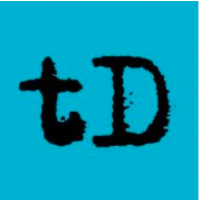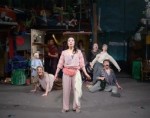Credit Where Credit is Due - a Letter to the Editor (of The New Yorker)
by Jane Goldberg
Joan Acocella, whose writing on tap master Savion Glover in The New Yorker has impressed me greatly, recently published this review of a new history of tap dance by New York Times dance writer Brian Seibert. In one or two spots while reading this I winced, being somewhat familiar with the eighties “revival” and those who helped bring it about.
Soon after Acocella’s review appeared, Jane Goldberg, one of those mentioned in it, sent out a public letter in response. I asked if we might reprint it on thINKingDANCE. Goldberg’s letter appears below. - Lisa Kraus
To the Editor:
In her extensive review of Brian Seibert's book, What the Eye Hears (November 30, 2015), I would have appreciated a disclaimer from Joan Acocella right up front, that Seibert was not only her mentee for at least two years in the early 2000s, but also that Acocella took him to numerous concerts, honed him as a critic, and most importantly, as dance critic and book reviewer for The New Yorker, herself, Acocella wrote him a strong recommendation letter to help him get his job for The New Yorker's "Goings on About Town." In her review, she indicates no personal relationship to Seibert.
It seems to be a conflict of interest, and in the tiny world of dance, not to mention tap, it's important to know the bias. I mention this as a probable conflict of interest because I was his mentor too during those exact same years. Seibert was using my tap archives extensively for his research and to my horror we had talked about Acocella's identity politics.
Not to take away from Seibert's tome, but I find it most disturbing when Acocella writes, "If Seibert betrays any identifiable bias, it's toward women. That's OK by me. Many male tappers, black and white, have taken female tappers less than seriously." Oh my. I guess that makes it all right.
While I appreciate being named one of the most important people to help save tap, Acocella ignores the fact that we white women weren't just "running around getting the old tappers their meds, and driving them to their appointments." We were actually dancing in our own shows, often including the old black "masters" as guest artists, or integrating (sic) them into our shows. We choreographed or improvised, creating solo and ensemble works, and most strove to keep the art moving forward.
I am speaking of companies like Jazz Tap Ensemble (CA), Manhattan Tap (NY), Gail Conrad (NY), Andrea Levine (NY), Linda Sohl Ellison (CA), Brenda Bufalino (NY), Acia Gray (TX), Carol Vaughn (Wash. D.C.), Sarah Petronio (Paris), Anita Feldman (NY), Katherine Kramer (KY), Jackie Raven (NY), Pam Raff (MA), Dianne Walker (MA), myself (NY), and many others I've probably left out.
In the words of Ishmael Reed, in his book Mumbo Jumbo, the art form of jazz "jes grew." This applies to tap, whose roots are in jazz. It was all in a burst of energy around the same time (late 70s-early 80s) to search for the authentic and to build new audiences.
Maybe we should be "honored" as Acocella writes, but we like to think it was our dancing too, that was being noticed, and paving the way for a new generation like Michelle Dorrance and Dormeshia Sumbry Edwards, mentioned at the end of Acocella's review. Basically, all of us fell in love with tap, and loved to do it.
Acocella felt tap needed a savior, a big star like Gregory Hines, but that is missing the big picture. 1978 was a pivotal year for tap—not only did Hines star with his brother on Broadway in "Eubie," but many of us downtowners and out-of-staters were laying the groundwork for a resurgence of interest in the so-called "lost or dying art of tap." Gregory himself told me over the course of 25 years of talking tap with him that he knew white women brought tap back, not only as producers, but as performers. (I have an audiotape of him saying this in my archives.)
Hines himself had to produce tap. He was one of the executive producers of the film Tap! (1989), and has producing credits for the Gregory Hines PBS special Tap Dance in America and for a big show at Carnegie Hall. His main ambition was to see that other tap dancers could make a living from tap dancing.
So it's hard to be dismissed when Acocella writes that Seibert’s book's one serious fault is his inclusiveness. You guessed it: the first on her list of things she didn’t need to read about was “the small tap groups of the seventies and eighties...who are not compelling enough to merit the space that Seibert gives them." Seibert also talks about tap's globalization, citing Germany, Japan, France, South America and other countries to demonstrate how the American art form was spreading. Referring to this section, Acocella concludes, "I wish them well, but until they do something of note, I don't need to read about them."
I, for one, find it interesting that Acocella could also do without ditties such as tap never catching on in Africa, and finding out that Hitler loved Fred Astaire! It’s fine to see Acocella writing so much on a subject she rarely follows—but I would be the first to challenge her, as a main player in the 70s and 80s, because she rarely, if at all, came, let alone, reviewed, any of the aforementioned 70s and 80s small groups, or the global tap movement.
And that is a shame. She has covered Savion Glover, and that is about it. Most people know that movements start from the ground up. If Acocella wants to write a review about a book on a history of tap, while she herself has paid so little attention to its evolution and the varied influences exerted on it through the years, she might begin by acknowledging her biases and the limitations of her expertise.
Jane Goldberg
Director, Changing Times Tap (1979 incorporated)
See also a tD review of Dorrance Dance by Ellen Chenoweth and Lisa Kraus.
December 18, 2015







